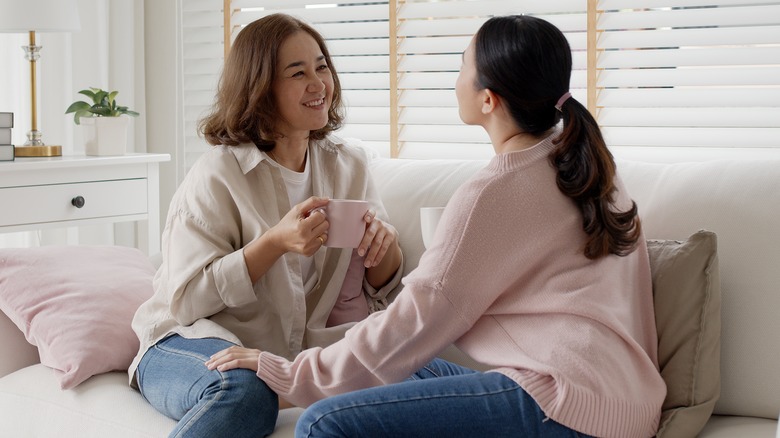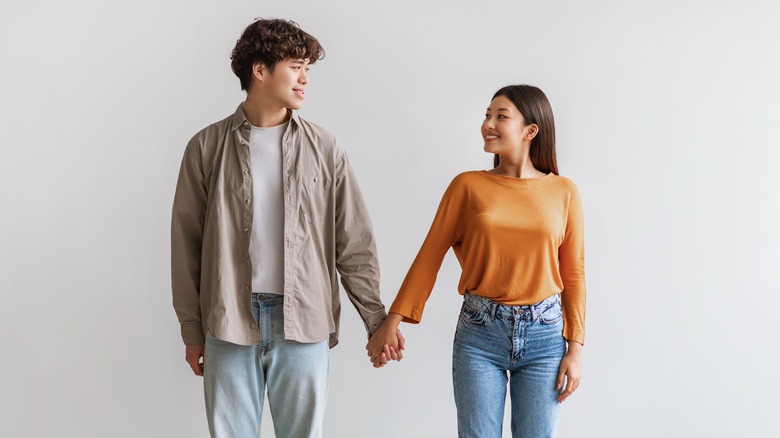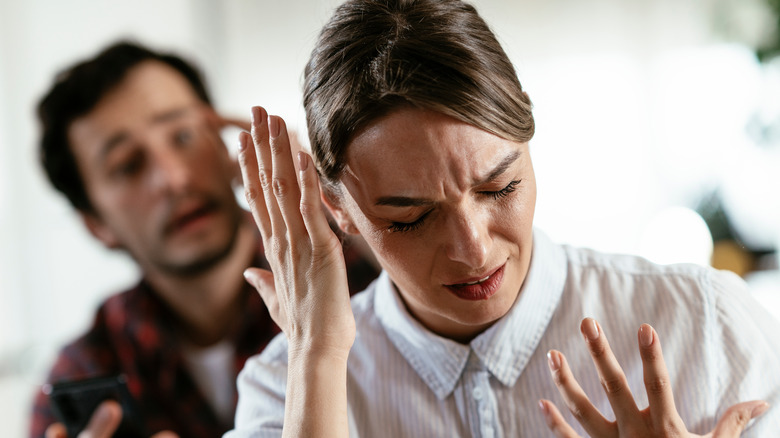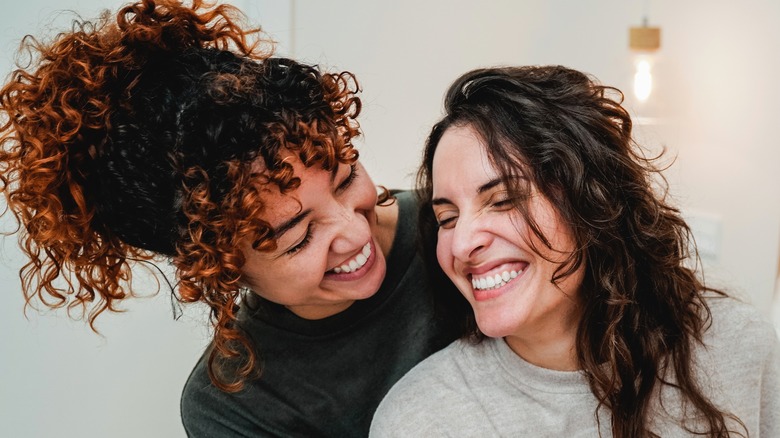What You Should Know About Attachment Styles In A Relationship
Have you ever wondered why you push your partners away, choosing to pick fights or pretend that you don't care when you really do? Do you find yourself repeatedly making the same mistakes in your relationships? Perhaps you often feel worried, jealous, or clingy. When it comes to making a commitment to another person, do you feel emotionally prepared to take them on or do you often feel the urge to flee? If you find yourself consistently struggling with the same relationship problems over and over again, understanding your personal attachment style may help you break the cycle.
It is human nature to belong, and for many that means being accepted within a fulfilling, healthy relationship, per Psychology Today. However, many people struggle to achieve that and wonder what exactly they're doing wrong. Recognizing your attachment style is useful for gaining insight into unhealthy behaviors, particularly those that affect your relationship. Attachment styles can be used to identify how you connect with other people, how you relate to them, and how you navigate physical and emotional intimacy. It can also help you understand the way you communicate with your romantic partner and why it might not be working.
All relationships are unique and will come with their own set of problems. No matter what issue you have or the personal struggles you strive to overcome, identifying your attachment style and its impact on your relationship is a great place to start the healing process (via All Points North).
What is attachment theory?
Attachment theory is a psychological concept developed by British psychiatrist John Bowlby in the late 1950s. According to Simply Psychology, Bowlby explored the idea that early life experiences played a significant role in emotional behaviors exhibited later in life. In other words, how parents or caregivers raised you, as well as the emotional bond you shared, directly influence how you navigate adult relationships. Bowlby believed the biological purpose of these attachment styles was to ensure our survival as a species. By forming attachments with our parents, we learn how to express our needs and establish ourselves as part of a group, which historically meant safety and shelter. Bowlby also concluded that social and emotional problems can develop later on if stability and comfort are not provided in our formative years.
Bowlby's initial theory was expanded upon by University of Denver psychologists Cindy Hazan and Phillip Shaver, who focused on applying the attachment theory to adults in romantic relationships. Hazan and Shaver believed that our attachment style in childhood was an accurate predictor of our relationship style into adulthood, per APA PsycNet. Through self-report tests, they determined that the warmth and support of caregivers directly corresponded to higher secure attachment scores as adults. Meanwhile, professors Dale W. Griffin and Kim Bartholomew's 1994 paper, which improved upon the measurement of adult attachment, have increased our ability to understand attachment theory and its impact on our relationships with our partners (via Reinvention).
What are the different attachment styles?
There are four different attachment styles that describe the nature of emotional attachment in humans. These are identified as secure, anxious, avoidant, and disorganized. According to The Attachment Project, attachment styles may remain stable once they have developed. Your type of attachment can also fluctuate as you adapt to new environments, new relationships, or grow through the different phases of adulthood. Regardless of the attachment style you align with, they can all have positive and negative ramifications on your relationships.
Humans are complex creatures which means that nobody fits exactly within the confines of a particular attachment style. It is generally acceptable to be categorized in any one of the types of attachment, per Psychology Today. Whether secure or insecure, each attachment style simply indicates how you cope with your environment and the people within it. This can apply to platonic relationships, including those with friends and coworkers. However, understanding your own style of attachment may also help answer questions you have about the way you interact with your partner, why past relationships have failed, or how to identify common problems that come up in your relationships. Knowing your attachment style can even help you to change it if you wish, through intentional goal-setting and mindfulness.
Secure attachment style
According to Psych Central, secure attachment is the result of feeling safe, understood, supported, and valued growing up. This style allows people to build healthy, long-lasting relationships that rely on clear communication, emotional availability, safety, and connection. People who have secure attachment styles are able to navigate relationships well due to their trusting, positive natures. They do not feel threatened by the little things that insecure attachment styles do. They are as confident in their ability to be alone as they are to be in a relationship and have developed high self-esteem and a strong sense of self-worth.
Furthermore, people with secure attachments crave closeness and intimacy with their partners and strive to be open and honest at all times. They employ empathy to understand the feelings of others and work together to solve any problems that can arise (via Evergreen Psychotherapy Center). They are adaptable and forgiving of their partner's mistakes, choosing to view their intentions as positive regardless of the outcome. Most importantly, people with secure attachment styles understand that they are worthy of love, which often removes jealousy and anxiety from the relationship.
Secure attachment is the ideal attachment style, according to CNBC. Even if you do not initially have a secure attachment style, one can be forged through grounding techniques, reflecting on positive memories, practicing expressing your feelings, and working on emotional self-regulation when interacting with your partner.
Anxious attachment style
Adults with an anxious attachment style are constantly worried about their partner's availability or commitment to the relationship. These styles can stem from overprotective parents, unreliable caregivers, or neglect during childhood. Studies also show a genetic predisposition to anxiety in general, which can lead to separation anxiety later on in life.
People with anxious attachment styles are often seen as clingy due to their underlying fear that their partner will abandon them. They long for closeness and connection but can overdo it, exhibiting behaviors that can end up pushing their partners away. These people often have hypersensitivity to rejection, negative self-worth, and low self-esteem. Deep down, people with attachment anxiety don't believe they are worthy of being loved or supported. They project this insecurity onto their partner, acting mistrustful of their partner's intentions, regardless of their intended intention or impact, while simultaneously depending on them to meet every need. This attachment style tends to overanalyze the actions of others as well.
Someone in a relationship with a person who has an anxious attachment style often tires of having to provide constant support and reassurance. While their anxious partner's initial attempts to bond and spend every moment together are seen as sweet or special, it quickly becomes overbearing. According to Current Opinion in Psychology, the lack of emotional regulation, independence, and their fear of being rejected can end up leading to resentment on their partner's end, which can cause conflict resulting in the end of the relationship.
Avoidant attachment style
The opposite of anxious attachment is avoidant attachment, also referred to as dismissive attachment. People with this style of attachment prioritize their own independence and need for control over their partner's needs. They are also highly self-sufficient people who try to avoid depending on others for anything (via Envision Wellness). This means they are often shut off emotionally from other people. If you have an avoidant attachment style, you likely struggle with putting your partner first, displaying physical or verbal affection, or feeling as though you deserve those same things in a relationship.
As a result, people who develop avoidant attachment styles have an unhealthy view of what behaviors are causing their partner pain or confusion. They run hot one minute and cold the next. They often view their partner's desire to spend time together or make plans as clingy. Normal relationship behaviors such as expressing emotions, working through conflict, or feelings of reliance on your partner can cause this attachment type to feel uncomfortable, per Relish. In response, they shut down and attempt to distance themselves as efficiently as possible, often at the expense of their partner's feelings.
A lack of communication within a relationship is often a common sign of avoidant attachment styles. It often stems from caregivers who were uncomfortable expressing emotion and viewed repressing their feelings as a strength of character. According to Marriage, helping avoidant people feel comfortable communicating their emotions encourages them to open up and build a trusting bond.
Disorganized attachment style
The disorganized attachment style is ultimately the most intense type of insecure attachment style, per Psychology Today. Also known as fearful avoidance, this attachment style oscillates between desiring love and affection and being extraordinarily afraid of it. According to Briana MacWilliam, their perspective on their relationship with their partner can change abruptly. One minute they love and trust their partner unconditionally, and the next they see them as a villain sent to destroy their happiness.
Fears of rejection, abandonment, and being vulnerable to another person are often experienced by people with a disorganized attachment style. Once they are in a happy, loving relationship, people with disorganized attachment start out with high expectations. Before long, they begin to feel distrustful of their partner's intentions and experience large amounts of jealousy. They may test their partner's commitment to the relationship by picking fights or violating their partner's privacy, all in an attempt to prove this person is not right for them. Before long, the relationship can end badly, and the person with a disorganized attachment feels let down by the entire experience.
In general, people with disorganized attachment are seen as moody or intense. They feel their emotions very strongly and express them in ways that are not always conducive to a trusting, healthy relationship. Although these traits make them creative, thoughtful, and compassionate people, they are often lonely and disconnected from the people they want to spend time with the most.
How does your attachment style affect your romantic relationship?
Each attachment style has positives and negatives, especially regarding its effect on romantic relationships. According to Psychology Today, adults look for romantic partners that help confirm their previously developed attachment pattern. For example, securely attached people feel comfortable seeking out a loving partner that offers them independence and support. They don't need to be reassured that their partner loves them and they don't feel threatened by conflict or disagreements. Instead, they are generally optimistic about their relationship and view their partner in a positive light. Securely attached individuals have the ability to set boundaries but are willing to be honest and vulnerable when the situation calls for it.
Insecure attachment styles struggle more when it comes to maintaining their relationships. Anxiously attached people tend to cling to their romantic partners for fear of being rejected. If their needs are not met, they tend to seek constant reassurance from their partner, depending on them for validation and emotional regulation (via Psych Central). An avoidant person is terrified of losing their independence, and will keep potential partners at a distance to avoid experiencing real feelings. They also struggle to express true emotions, which can make their partners feel unneeded.
People with disorganized attachment may exhibit a combination of insecure attachment styles in their romantic relationships. Trust is difficult for them and they experience high levels of anxiety or push their partners away to cope with their fear of love and intimacy.
What attachment styles pair well together?
Certain attachment styles pair better together in romantic relationships than others. For example, securely attached couples are destined to do well together. While they can still experience conflict or have problems in their relationships, they are equipped with the necessary communication tools to face those problems in a healthy way (via Jeb Kinnison). People with a secure attachment style are also good for those with anxious or avoidant attachment styles. A secure person can help assuage the worry of an anxious person and help a dismissive person work on their ability to express themselves. As long as both parties learn to communicate and contribute to the demands of the relationship, they can hopefully move forward together.
According to The Love Compass, two avoidant people can end up with intimacy issues while in a functional and emotionally distant relationship. Cohabitating is easy with this pairing, but serious work will need to be put into the communication and emotional aspects of the relationship if it is to last. An anxiously attached couple can also make a relationship work. As people who crave intimacy and closeness with their partner, they will be highly empathetic to one another's needs. They will also be able to identify subtle shifts in the relationship, for better or worse. In this pairing, it is important for both parties to acknowledge they want the same things, and to learn to let go of jealousy and unsubstantiated worries that pop into their heads.
What is your personal attachment style?
There are numerous resources available if you want to find out what your personal attachment style is. Although we don't have any control over what our attachment style is, knowing it has many benefits, including making you feel more secure in your relationships (via NPR). Being aware of your personal attachment style may help answer questions you have about why you connect with certain types of people, as well as predict the future success of your existing relationship.
It is important to keep a couple of ideas in mind when you identify your personal attachment style. First of all, remember that no attachment style is classified as bad or good. The styles simply help us understand how we react to the world around us, and how we interact with the people in our lives. Second, it is important to understand that people often exhibit traits or behaviors from all four attachment styles, as noted by Psychology Today. If you feel that your personal attachment style is limiting your ability to connect with others or maintain a successful, happy relationship, it is possible to relearn behaviors that will help your attachment style change.
Can you change your attachment style?
Roughly 50% to 60% of people have a secure attachment style, per HelpGuide. The remaining 40% with an insecure attachment style may feel distressed by their anxious, avoidant, or self-sabotaging tendencies. However, this does not mean that you are doomed to an unhappy life or a never-ending lineup of disappointing relationships. According to Psych Central, changing attachment styles is entirely possible with patience and dedication.
Sometimes a person's attachment style changes naturally due to growing up and maturing. As we age, we generally have less patience for relationships that don't make us happy. Being in a romantic partnership with a securely attached person can have an effect on your own attachment style. Their comforting, supportive presence can teach you how to let go of the anxieties you may have held previously, helping you to transition to a more secure attachment over time.
The most common way to change your attachment style is to do so mindfully. Becoming self-aware of your current behaviors and existing attachment styles can help you shift your perspective (via the European Journal of Personality). By figuring out what habits don't work for you and what actions are holding you back from a healthy relationship, you can ease yourself into new ways of behaving that will benefit both you and your future partner.










